Hey dears, have a look on our Official Zagoa Teaser 2014!
Thanks Tarik khabouiz for your beautiful work.
We are waiting for you! We will colourize the desert!!
Share it, post it, let’s put together our common dream
http://youtu.be/Jv208qXOboo

Switzerland's Veejays Portal
Hey dears, have a look on our Official Zagoa Teaser 2014!
Thanks Tarik khabouiz for your beautiful work.
We are waiting for you! We will colourize the desert!!
Share it, post it, let’s put together our common dream
http://youtu.be/Jv208qXOboo
E-TICKETS
IMPORTANT! READ CAREFULLY THE TERMS & CONDITIONS BELOW!!
¨¨¨¨¨¨¨¨¨¨¨¨¨¨¨¨¨¨¨¨¨¨¨¨¨¨¨¨¨¨¨¨¨¨¨¨¨¨¨¨¨¨¨¨¨¨¨¨¨¨¨¨¨¨¨¨¨¨¨¨¨¨¨¨¨¨¨¨¨
The following applies to ticket purchasers/holders. Please read carefully the terms & conditions. All transactions are protected and 100% Guaranteed. Make sure that all the requested informations are correct and valid, this is our main way to get in touch with you! The invoice and the ticket purchased are sent to the e-mail address of the purchaser.
¨¨¨¨¨¨¨¨¨¨¨¨¨¨¨¨¨¨¨¨¨¨¨¨¨¨¨¨¨¨¨¨¨¨¨¨¨¨¨¨¨¨¨¨¨¨¨¨¨¨¨¨¨¨¨¨¨¨¨¨¨¨¨¨¨¨¨¨¨
* ONLINE TICKET PURCHASERS/HOLDERS! THE CREDIT CARD USED FOR THE PAYMENT IS REQUIRED AT THE FESTIVAL GATE! IF YOU ARE NOT ABLE TO PAY ONLINE FOR ANY REASON STATEMENT IN THE TERMS & CONDITIONS BELOW, REFER TO “MONEY TRANSFER” OR “PAYPAL” SECTION TO AVOID ANY KIND OF PROBLEM!!
TERMS AND CONDITIONS
* FESTIVAL LIMITED TO 1000 PEOPLE!* Aged under 15’s must be accompanied by over 18′s!!* You must be 18 to buy alcohol from the bars, bring alcohol with you or drink alcohol at the festival!* Glass bottles are not allowed on the festival site!* WARNING: EXCESSIVE EXPOSURE TO LOUD MUSIC MAY CAUSE DAMAGE TO YOUR HEARING!* A 6,00 € / 66,00 Mad DEPOSIT WILL BE ASKED AT THE GATE, REFUNDED BY BRINGING FULL THE GARBAGE BAG PROVIDED, AT THE END OF THE FESTIVAL
TICKETS:
* ONLINE TICKET PURCHASERS/HOLDERS! THE CREDIT CARD USED FOR THE PAYMENT IS REQUIRED AT THE FESTIVAL GATE! IF YOU ARE NOT ABLE TO PAY ONLINE FOR ANY REASON STATEMENT, REFER TO “MONEY TRANSFER” OR “PAYPAL” SECTION TO AVOID ANY KIND OF PROBLEM!!
* TO AVOID ANY KIND OF PROBLEM, BUY YOUR TICKETS ONLY FROM OUR WEBSITE OR “AMBASSADORS” LISTED IN THE SECTION CONCERNED!
* EACH TICKET IS UNIQUE! ONCE SCANNED AT THE GATE, ANY OTHER COPY OF IT WILL BE NULL AND VOID!! THE TICKETS ARE NOMINATIVE AND PERSONNEL! NON CHANGEABLE AND NON REFUNDABLE!! AN ID/PASSPORT IS ALSO REQUIRED FOR EACH TICKET AT THE FESTIVAL GATE.
* TO ENSURE PROPER SCANNING OF YOUR TICKET, PLEASE PRINT IT ON A4 SIZED PAPER.
SHUTTLES:
* Seats are limited!
* By booking Zagoa shuttles, you save in time & energy, and it cost you the same price as public busses!
* You have to be at least 15mn before your shuttle departure! Attention, the bus will not wait for you!!
* Shuttle prices include 1 transfer to the festival area!!
* The festival area will be served by Zagoa Bus to/from the meeting point and partner hotels only (20 min driving), you will have to pay 15,00 € / 165,00 Mad (unlimited transfers for the entire duration of the festival) to access the site or get back from it, no taxi or other private transport company will have access apart the festival shuttles or cars and trucks of the attendees.
* Zagoa bus to/from the festival Area is served every 20mn!
* For special transfer requests, please send an email to shuttles@zagoafestival.com
* Shuttles Pre-sales will end on May 5th!
* Seats are not available at the stations!
ACCOMMODATIONS:
* Nomad tents and African lodges on the festival ground can be reserved only for the entire duration of the festival!
* Hotels around can be reserved only for the entire duration of the festival!
* The minimum stay of charming accommodations during the festival is 3 successive nights, you will have to select your charming accommodation pack on the purchase form and fill out the section concerned with the check-in/check-out dates!
* Festival ground accommodation pre-sales end on May 5th!
* Hotel accommodation pre-sales end on May 13th!
* Rooms lefts are available for the firsts arrived!
* African lodges and charming tents are not available at the festival gate!
* Nomad tents gate price is 20,00 € /220,00 for 1 night! No more than 40 beds available on site!!
First arrived, first served!
* THIS STEPS ARE NECESSARY TO PREVENT FRAUD. ANY PURCHASE NOT MATCHING THE PREDICTED STEPS, WILL NOT BE ACCEPTED AT THE FESTIVAL GATE!!
BE INFORMED WITH UPDATES BY SUBSCRIBING TO OUR NEWSLETTER!
getticket
News
++ 1 week ago ++
NEWS FEBRUARY 2014
++ 2 weeks ago ++
PURCHASING ONLINE, VIA PAYPAL OR VIA MONEY TRANSFER!
++ 4 weeks ago ++
NEW ZAGOA WEBSITE
Movie Exporter v0.0.20091011 3.44 MB
~/Library/Graphics/Quartz Composer Plug-Ins (~ sign stands for home directory, so it is /Users/YOUR_USERNAME/Library/Graphics/Quartz Composer Plug-Ins)/Library/Graphics/Quartz Composer Plug-InsTIMEGATE 10 Years – New Year Festival
Monday 30 december 2013 _ 20h to wednesday 1 jan 2014_18h
Live
✷ 30.12.2013 ** SECOND FLOOR **
► Dark psy, psytrance, progressive
BRAINDRIVER (Fractal – Dropland) F
ELECTRYPNOSE (Electrypnosis media ) CH
SYNTHETIK CHAOS (Bom shanka – World people – Sangoma) F
TELEPATHIC VISION (Biolive) PT
▀▀▀▀▀▀▀▀▀▀▀▀▀▀▀▀▀▀▀▀▀▀▀▀▀▀▀▀▀▀▀▀▀▀▀▀▀▀▀▀▀▀▀▀▀▀▀▀▀▀
✷ 31.12.2013 ** MAINFLOOR **
► psytrance & progressive
ALLABY (Nano) UK
BRAINIAC (Grasshopper) HR
DAY.DIN (Spin Twist) DE
HYPERFREQUENCIES (Mandala) F
LYCTUM (Tesseractstudio) SRB
NOK (Blue tunes) DE
NUKLEALL (Blacklite) – IT
PAUL TAYLOR (mutagen) UK
SENSIFEEL (One feel ) F
SONIC SPECIES (Alchemy) UK
▀▀▀▀▀▀▀▀▀▀▀▀▀▀▀▀▀▀▀▀▀▀▀▀▀▀▀▀▀▀▀▀▀▀▀▀▀▀▀▀▀▀▀▀▀▀▀▀▀▀
✷ 31.12.2013 ** SECOND FLOOR**
► electro techno & multi progressive
ELECTRYPNOSE (electrypnosis media) CH
SENSUAL SQUEAK (amplidudes ) CH
▀▀▀▀▀▀▀▀▀▀▀▀▀▀▀▀▀▀▀▀▀▀▀▀▀▀▀▀▀▀▀▀▀▀▀▀▀▀▀▀▀▀▀▀▀▀▀▀▀▀
DJs
✷ 30.12.2013 ** SECOND FLOOR **
► Dark psy, psytrance, progressive
ARMONIX (Solar tech) CH
BLUEFISH (Underwater music) CH
COSINUS (Sangoma) CH
DHARMA (Lunarmouth) F
FOG & PHOBOS (Looney moon) IT
VISHUDHA (Fractal – Mechanik) MX
SEBASTIAN KOS (Antu) CH
UFORIK (Tribe of surya) CH
▀▀▀▀▀▀▀▀▀▀▀▀▀▀▀▀▀▀▀▀▀▀▀▀▀▀▀▀▀▀▀▀▀▀▀▀▀▀▀▀▀▀▀▀▀▀▀▀▀▀
✷ 31.12.2013 ** MAIN FLOOR **
► Psy trance & multi progressive
DJOANNA (Spin Twist – Waldfrieden – One feel) DE
SOLARIS (Fractal) CH
MIZOO (Moonloop – Biolive) CH
MERCURY FALL (Moonloop) CH
OTEZUKA (Iono music) F
PAUL TAYLOR (Mutagen) UK
▀▀▀▀▀▀▀▀▀▀▀▀▀▀▀▀▀▀▀▀▀▀▀▀▀▀▀▀▀▀▀▀▀▀▀▀▀▀▀▀▀▀▀▀▀▀▀▀▀▀
✷ 31.12.2013 ** SECOND FLOOR**
► electro techno & multi progressive
ANIMARILYS (Mad Mushrooms) / CH – F
ACIDHAT (Mindwave project) CH
DRENAN (Iono music) F
DVX (GoaLoveBoat / Basel ) CH
DAVID FRAKA (Tribal vision) CH
JOHNSON (Lexicon – Sprout ) DE
MERCURY FALL (Moonloop) CH
PROFESS0R M (Teratone) F
REM (Tesseractstudio – Dream & fly) F
SENSIFEEL (One feel ) F
▀▀▀▀▀▀▀▀▀▀▀▀▀▀▀▀▀▀▀▀▀▀▀▀▀▀▀▀▀▀▀▀▀▀▀▀▀▀▀▀▀▀▀▀▀▀▀▀▀▀
Chill
✷ 30.12.2013 ** PARALLEL FLOOR **
► Ambient, electronica, progressive chill trance
⦿ Live acts :
ASURA (Ultimae) F
AKSHAN (Altar) F
BASTOR (Static) CH
LOGIC WAVE (Mad mushroom) CH
MNNSK (Databloem) CH
⦿ Dj’s :
DEIKO – PT
TELEPHATIC ANIMALS (Biolive) PT
MIZOO (Ultimae – Biolive) CH
PSYCHOPHONIC (Lunarmouth – Tori ) F
SPIRAL HAND (Tribe of surya / Intensive crew ) CH
▀▀▀▀▀▀▀▀▀▀▀▀▀▀▀▀▀▀▀▀▀▀▀▀▀▀▀▀▀▀▀▀▀▀▀▀▀▀▀▀▀▀▀▀▀▀▀▀▀▀
✷ 31.12.2013 ** PARALLEL FLOOR **
► downtempo, deep tech-house, multi progressive
⦿ Live acts :
MAHA SUN (Aphonix – narmada music) CH
MAHI (Aphonix – Narmada music) CH
MINFEEL (One feel) F
⦿ Dj’s :
DJOANNA (Spin Twist – waldfrieden – One feel) DE
FAFA (Tecols family) CH
LOCOMOTIV (Jurassik full power) CH
MAPUSA MAPUSA (Lexicon – sprout ) DE
MYSTICAL IMPACT (Psygoactive tribe) CH
OTEZUKA (Iono music) F
RANDY (Fractal) CH
SISMO (Lunarmouth – tori) F
SLEEPY (Delta force) CH
SYSYPHE (Hadra – ultimae) F
Deco
▀▀▀▀▀▀▀▀▀▀▀▀▀▀▀▀▀▀▀▀▀▀▀▀▀▀▀▀▀▀▀▀▀▀▀▀▀▀▀▀▀▀▀▀▀▀▀▀▀▀
✷ DECO
IV-3D (Biolive)
LES LUCIOLES (Hadra)
FLOWERS OF LIFE
ART MANIF
MAE & MOA (One feel)
FLOATING BUSH Collective Deco
✷ VJ’S
NATARAJA VEEJAY
AT-OM
PIXELMATSCH
SISTER RAY
DOBERMANN VJ
VISUAL INVADERZ
VJ VIRUS
VJ XAMARU
VJ IVAN
VJ UZAKO
▀▀▀▀▀▀▀▀▀▀▀▀▀▀▀▀▀▀▀▀▀▀▀▀▀▀▀▀▀▀▀▀▀▀▀▀▀▀▀▀▀▀▀▀▀▀▀▀▀▀
Location
Complexe 3d – Tennis Couvert d’Ajoie
Porrentruy / Jura / Switzerland
▀▀▀▀▀▀▀▀▀▀▀▀▀▀▀▀▀▀▀▀▀▀▀▀▀▀▀▀▀▀▀▀▀▀▀▀▀▀▀▀▀▀▀▀▀▀▀▀▀▀
✷ From Germany :
Go tho Basel and follow Porrentruy via Delémont.
✷ From France, Italia, Austria :
Go to Delémont and follow Porrentruy
▀▀▀▀▀▀▀▀▀▀▀▀▀▀▀▀▀▀▀▀▀▀▀▀▀▀▀▀▀▀▀▀▀▀▀▀▀▀▀▀▀▀▀▀▀▀▀▀▀▀
✷ By car :
Highway (E27/A16) Exit Porrentruy-Est
Turn left at the 1st & 2nd round-abouts
and follow the signs
✷ By train : [cff.ch]
less than 3 hours from Geneva / Zürich / Paris / Strassbourg / Freiburg i.B (D)
less than 4 hours from Frankfurt / Friedrichshafen (A) / Lyon (F)
✷ By plane : [euroairport.com]
the nearest airport : Euroairoport Basel / Mulhouse / Freiburg
▀▀▀▀▀▀▀▀▀▀▀▀▀▀▀▀▀▀▀▀▀▀▀▀▀▀▀▀▀▀▀▀▀▀▀▀▀▀▀▀▀▀▀▀▀▀▀▀▀▀
Map
Entry fee
▀▀▀▀▀▀▀▀▀▀▀▀▀▀▀▀▀▀▀▀▀▀▀▀ ▀▀▀▀▀▀▀▀▀▀▀▀▀▀▀▀▀▀▀▀▀▀▀▀ ▀▀
★☆★☆★☆★☆★☆★☆★☆★☆★☆★☆★☆★☆ ★☆★☆★☆★☆★☆★☆
TICKETS INFORMATIONS FOR THE TIMEGATE 10TH
Presales | Préventes: Prix préventes + taxes
★ Until 31.10: 30.12 (Chf 35) (30€) | 31.12 (Chf 67) (56€) | 2 nights (Chf 80) (67€) (500Tickets)
★ Until 30.11: 30.12 (Chf 39) (33€) | 31.12 (Chf 72) (60€) | 2 nights (Chf 85) (71€) (1200Tickets)
★ Until 27.12: 30.12 (Chf 43) (36€) | 31.12 (Chf 79 (66€) | 2 nights (Chf 93) (78€) (1800Tickets)
★ At Doors 30.12 Chf 50.- euros 42.- / 31.12 Chf 90.- euros 75.- / 2 nights Chf 110.- euros 92.-
Limit : 3500Tickets
Suisse: Starticket
★ 30.12.2013
[starticket.ch]
★ 31.12.2013
[starticket.ch]
★ 2 nights
[starticket.ch]
International : Weezevent
[weezevent.com]
▀▀▀▀▀▀▀▀▀▀▀▀▀▀▀▀▀▀▀▀▀▀▀▀ ▀▀▀▀▀▀▀▀▀▀▀▀▀▀▀▀▀▀▀▀▀▀▀▀ ▀▀
sur place :
★ 30.12 Chf 50.- euros 42.-
★ 31.12 Chf 90.- euros 75.-
★ 2 nights Chf 110.- euros 92.-
▀▀▀▀▀▀▀▀▀▀▀▀▀▀▀▀▀▀▀▀▀▀▀▀ ▀▀▀▀▀▀▀▀▀▀▀▀▀▀▀▀▀▀▀▀▀▀▀▀ ▀▀
Info
10TH EDITION OF TIMEGATE FESTIVAL. DON’T MISS IT!
▀▀▀▀▀▀▀▀▀▀▀▀▀▀▀▀▀▀▀▀▀▀▀▀▀▀▀▀▀▀▀▀▀▀▀▀▀▀▀▀▀▀▀▀▀▀▀▀▀▀
✷ 360° main floor edition
30th December 2013 to 1st January 2014
Porrentruy / Jura – Switzerland
✷ 3 days – 2 nights
2 floors on 30th – 4 floors (main floor) on 31th
Start 30th 20h to 1st 18h.
✷ 4th floor : info tba
✷ Food & drinks area / shops
Remember come before midnight or you will miss some great animations.
Only closed water allowed. Smoking areas.
Organizer
BIOLIVE
Email
info@biolive.ch
Web
[BIOLIVE.CH]
GrandVJ 2 comes with a new interface, making it even more user friendly and straightforward, while integrating new functionalities in it.
| Download | Upgrade Info |
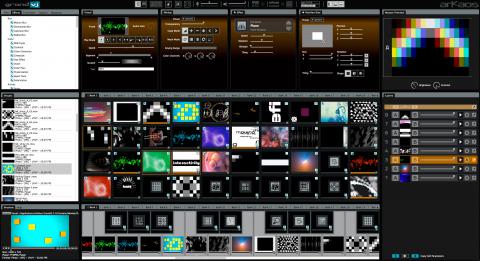
Manipulate, trigger and mix video clips with sound, animated text strings or live cameras in much the same way as mixing music to create a spectacular audiovisual show. GrandVJ can mix up to 8 layers with a vast library of video effects, transitions and sound driven visual generators.
The A/B crossfading mode with independent preview makes it incredibly flexible to perform live, and the Browser Preview feature lets you preview visuals, effects, transitions and sources before sending them to the output, just like a DJ previews his next track in his headphones.
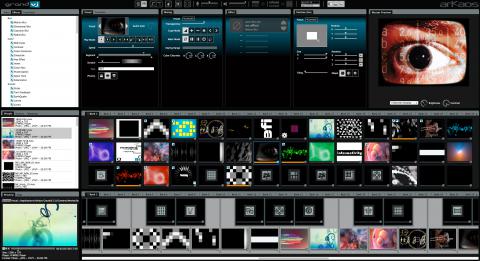
GrandVJ runs on both PC and Mac and accepts all common video and image formats. Its intuitive interface lets you turn your keyboard into a super controller for zipping through the functions. Need more? GrandVJ’s learn mode makes it a breeze to set up any MIDI controller and with support for the network based OSC protocol you can even control GrandVJ with an iPhone or an iPad. Hook it up and start the show!
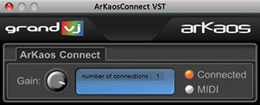
The ArKaosConnect plug-in allows GrandVJ to receive sound and MIDI from any audio sequencer compatible with VST plug-ins, running on the same machine or on another machine on the network. Incredibly easy to setup, the plug-in configures itself automatically!
For VJs, ArKaosConnect enables a new level of interaction with Musicians.
For Musicians, ArKaosConnect makes it fun and easy to add a video track to compositions during live performance.
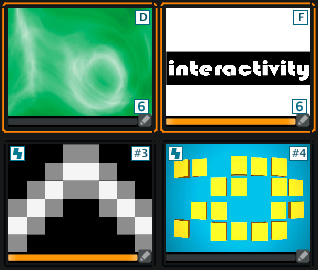
GrandVJ is very easy to customize to each user’s preferred setup. The interface can quickly be modified to fit individual needs and preferences.
Mapping MIDI controllers with the new learn mode is easy as pressing keys on your device but you can also import predefined presets for the most common MIDI controllers.
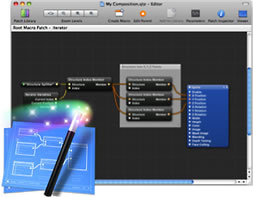
Click here for more GrandVJ videos
more info : arkaos.net
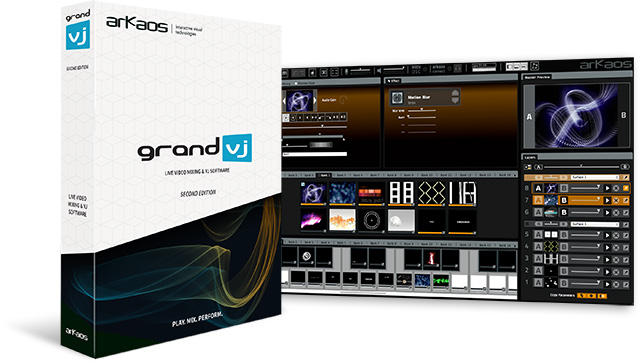
You can already get your GrandVJ 2 license now and start working with the Beta version, or choose the GrandVJ XT license and get access to the new Video Mapper extension!
| Download Beta | Upgrade Info |
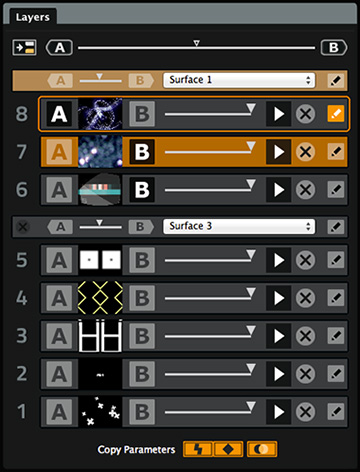
GrandVJ 2 comes with a new interface, making it even more user friendly and straightforward, while integrating new functionalities in it.
We’ve added cool new effects such as « Edge Glow », « Video Signal Distortion » or a very useful « Color Correction » effect that can help you quickly fix Hue, Saturation or Lightness on a video in a live environment.
The video processing engine has been updated, bringing support for the latest codecs and improving performance with older ones thanks to a better use of multithreading.
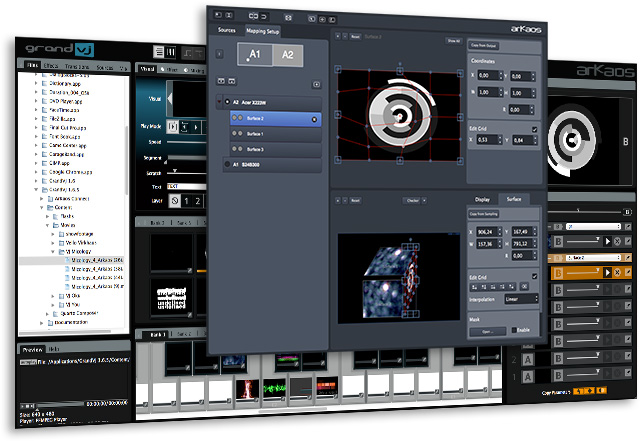
GrandVJ XT is an “extended” version of GrandVJ 2 which adds expert features such as the Video Mapper extension, allowing projection mapping and advanced management of multiple displays.
GrandVJ XT can send layer or cells output to virtual “surfaces” that can be scaled, deformed, and assigned to any physical output. One output can display a full screen visual or a composition of several mapped visuals, so you can easily create complex visual compostions on a set of LED screens – even with different resolutions – or just output to a video projector and deform the surfaces to flow them across any physical volume (like objects, or buildings..).
You can upgrade from any version of GrandVJ to GrandVJ XT from your customer account, now or later.
For our GrandVJ 1 users that are eager to use the Video Mapper, there’s a one step upgrade from GrandVJ 1 to GrandVJ XT with a -10% loyalty discount during one month.
We have completely reworked the software activation system to make it much more straightforward, flexible and user friendly (no more lengthy codes to copy/paste).
You can now activate and use GrandVJ 2 on up to two computers at the same time with one license (i.e. main computer and backup) – instead of one with the GrandVJ 1 license agreement.
You can also deactivate GrandVJ 2 on a computer before activating it on antoher, which allows temporary use of the software on any computer. The activation/deactivation process requires that you connect your computer to the Internet.
Introduction
The term VJ has grown to cover a wide variety of artistic and technological styles. The VJ is constantly pushing the boundaries and redefining what a VJ is and what a VJ does by utilizing practices that often seem so far stretched between them that it is increasingly harder to pin down what a VJ is all about. To demonstrate the evolving nature of the VJ term, one only has to notice the overlooked change in the meaning of the term itself: From VJ – Video Jockey to VJ – Visual Jockey, and to realize that VJing incorporates many more practices than just video mixing.
From Past to Present
The term VJ was first used in the late 70s in New York Club Peppermint Lounge and gained fame on MTV in 1981 when the presenters were described as VJs. In 1990 UK’s channel 4 artist show « Addictive TV » ran an article on the VJ culture on national television for the first time. However, the VJs historical roots can be traced to earlier periods than the term itself. In this essay I have decided to emphasize on two artistic approaches that, in my opinion, have had strong influences on the VJ culture and have determined the paths that VJ artists have taken. The first is the underground club culture and the second is the Avant-Garde art movements. These have had major influences on the way VJing is perceived today and on the way VJs describe themselves.
Paul Sharits in the 40s and Peter Kubelka in the 50s were the first to experiment with light, rhythm and music, with the intention of creating moving images people could dance to. In the 60s London had its own light show culture. In the infamous UFO club light shows were put on as art events. The artist Mark Boyle, who was regarded the father of English light-show, used slide shows showing bodily fluids such as urine and blood and became a well known figure of the international contemporary art scene
In today’s club culture, the role of a VJ is closely linked to that of a DJ, in the way that both are live performers in the clubbing scene: One mixes music and the other visual projected graphics. Both are based on technology and represent modernity, art and style. « Club cultures celebrate technologies […] and have led to formation of new aesthetics and judgements of value. » (Thornton, 1996, p. 4) It is fair to say that the term VJ has benefited from sounding similar to the term
DJ by helping to bring it to the public’s awareness and was intended to glorify the VJ culture and the VJ artist to a similar status of a DJ. However, to the VJ this has proven to be both a blessing and a curse. Club cultures are identified by the different styles of music that they play to different music cultures. DJs that come from those individual cultures are best suited to represent the type of sound for that crowd and more importantly, people who go to clubs want to dance. « Amongst youthful crowds, DJs were […] leaders and local celebrities. » (Thornton, 1996, p. 62). To club owners and the music industry « DJs have become a commodity, a name on a flyer, an investment. » (Haslem D. in Redhead, 1998, p. 161) To club owners the role of the VJ in the club is seen to be closer to that of a sound man or a lighting professional. The DJ has the status and the VJ will always be playing second fiddle in the clubbing scene, an aesthetic role, one which can be rendered to visual wallpaper.
The second approach to VJing originates from people like Malcolm LeGrice and Peter Gidal, who made experimental cinema, visual and performance art. They called it « Expanded Cinema » with ideas taken from post-Marxist idealism. They projected at multiple moving screens which represented an idealism of breaking out of the square medium. Artists such as Josef Beuys, Yoko Ono and John Cage used a mixture of different media as part of the Fluxus movement. When the Avant-Garde film makers collaged multiple images within a single frame, or painted and scratched film, or revolted against the indexical identity of cinema in other ways, they were working against « normal » film making procedures and the intended uses of film technology. (Film stock was not designed to be painted on). Thus they operated on the periphery of commercial cinema not only aesthetically but also technically. » (Manovich, 2001, p. 306) « Like the « artist – engineer » Constructivists, VJs innovate and modify existing tools and software to suit their needs. They often times build new custom tools and software, thus elevating the « craft » into other dimensions. » (Danto C. in Spinrad, 2005)
The development of graphics and video synthesizers by DIY electronic enthusiasts in the early 60s and 70s has given the ability for individuals to experiment with video graphics for the first time and another Fluxus member, Nam June Paik invented the PaikAbe video synthesizer. « As collage technique replaced oil paint, so the cathode-ray will replace the canvas. » (Dempsey, 2002, p. 257) In the 80s, technology allowed the development of video effects hardware that was purchased and spread to the clubbing scene. By the early 90s computers allowed the use of digital visual processing and the Amiga Video Toaster was one of the first desktop publishing systems. The first VJ aimed software was the Vujak which was written by Brian Kane and was then followed by fully functional commercial VJ applications such as MotionDive and VJamm.
The VJ has evolved out of the club scene and into other artistic disciplines like video art, performance art and interactive displays. The VJ term now incorporates video clip makers, video editors, animators, software designers, interactive and stage and light designers. VJs pride themselves on developing their own kits and installations in a DIY fashion. VJs have converged into every visual art form where technology is involved. But as things came naturally to the VJ, the correct definition of the term VJ has never been successfully established. VJs did not stop to think about their cultural role and their message, and so « VJ » became an empty term without a correct definition of its culture and values. « The definition of VJ has not been pinned down as it is still in its infancy. » (Walter, S. in D-Fuse, 2006, p. 46).
Club Culture vs. Art Culture
In the VJ community there seems to be a division between those who describe themselves as VJs, and occasionally use the VJ as a prefix to their name to describe who they are and what they do, and those who consider themselves media artists but still use the name VJ to categorize themselves.
The first type of VJ is usually associated with underground cultures and I will describe it as the « Club VJ ». Here the focus is on club and stage performances expressing one&s self more on the visual side of the art work. For here the image itself is the most important part of the show, the esthetics of the visuals, the quality of the rendered video and projected images. The sequence and the order of the videos and the layout of the visuals are what build the show. Club VJs are usually individuals who work on their own and try to make a name for themselves in the industry. To these artists the term VJ is important and an integral part of how they are perceived by the community. These artists may collaborate on other artistic projects and team up with other creative artists, usually on one-off events or projects, but seldom on an on going basis. « VJ Anyone » is a good example of this type of VJ. VJ Anyone gained his reputation in the club scene and on the stage doing gigs: « I spend a lot of time storyboarding my sets – good visuals work best in sequence, in context. Images can spoil each other if shown in the wrong order, in combination with conflicting subjects, colours and layouts. » (D- Fuse, 2006, p. 84) Artists like these will normally demonstrate their video clips on their website as promotion material of what they do and who they are.
The second type of VJ I am referring to is the « Artistic VJ ». Those will seldom define themselves as VJs and prefer to use terms such as media artists, visual artists, interactive artists or a variety of other bombastic definitions. When confronted with the question « Are you a VJ? » the response tends to be « I may do some VJ work occasionally » suggesting that the work of a VJ is confined to clubs and the dance scene and therefore does not represent the line of work they would like to be associated with. These types of artists normally work within a group or a company. Their title name will (probably) never have the term VJ in it. Even when asked directly about their VJ work, they seem to avoid using the term VJ to describe their work and instead will give examples that are related to other disciplines or change the subject altogether. As an example of this theory I will use Chris Allen of « The Light Surgeons », an internationally famous UK based group that has gained their reputation as experimental visual artists: « Our work is many things: filmmaking, installation and performance, as well as print and photography. It spills into many different disciplines and blurs the boundaries between art and design, film and theatre. It’s not about VJing – that is a term that I have never really felt described our work. It’s taking a more musical and expressionistic approach to filmmaking and design. » (D-Fuse, 2006, p. 87) According to this notion, the VJ artist seems to have lost his title (VJ). When a VJ works in a gallery space he will describe himself as a visual artist. When a VJ is involved with interaction he becomes as interactive artist, when a VJ takes to exploring musical content he becomes a musician. Where he creates his own filmed material he is a filmmaker, and when he combines them all he becomes a multidisciplinary artist or an artist – engineer Constructivist.
Influences on the VJ culture
As technology has evolved, so has the VJ artist with his love and enthusiasm for the latest technological inventions. VJs have embraced technology and used it to infiltrate into new practices. « It is fraudulent treating these diverse art forms as one. Other disciplines have had a bearing on A/V and VJ culture, as well as vice versa. » (Doyle, A. of OneDotZero in D-Fuse, 2006, p. 46) Technology has become the main driver behind the VJ into exploring new methods of visual creativity. The VJ expanded into other artistic disciplines and converged with other cultures.
‘Convergence has brought together technology applications with designers and artists. The diversity of the media landscape allows work to flow into many areas. It is now possible for creative people to work across a range of platforms using multidisciplinary tools. The hybrid creator brings new and collaborative ways of working […] it is relatively easy to cross these lines by any artist as the means of creation are easier to acquire.’ (Walter, S. of OneDotZero, in D-Fuse, 2006, p. 46)
The expansion into new disciplines was meant to satisfy the need and curiosity for new technology and experimentation. VJs are taking and influencing other cultures. This meant that the VJ culture was losing its identity. VJs were no longer describing themselves as VJs and were using descriptions from other disciplines to describe what they are and what the do. « With nothing progressive to say or do, subcultures stylists draw from and feed off each other in a cannibalistic orgy of cross-fertilization, destroying their own internal boundaries through the very act of expansion. » (Muggleton, D. in Redhead, 1998, p. 177)
The development of technology itself has had a big influence on the work VJs were producing. Following every new technological improvement, the VJ was keen to be the first to ‘wow’ the crowds with new technology based visuals and interactive displays that have not been seen by the public. Building new installations for events and developing new ways to produce graphics have become an art form itself. The machines generated the visuals with less and less direct control from the visual operator and the visual content that is displayed on the screen is not as important as the process of creating it.
‘If you look at the development of the software that live visual artists use from a time-line perspective, you can see a real influence of what came before and what after, a clear evolution. Research and design and programming and software are their own art form […] We’re getting to a point where the research and the process of creating tools that enable more artwork to be made is, to me, almost an extension of Performance as Object – sometimes that’s as much of an artistic moment as many of the objects, performances, and scores, that come out of it.’ (Forde, K. in Spinrad, 2005, pp. 39-40)
This creative approach obviously speaks to the art community that is interested in the process and have the tools to understand and evaluate the work based on the methods of creation. The types of visuals are generated from machines will often have a technological « feel » to them and are influencing the link between visuals and technology.
Is VJ a Subculture?
Clubs today have become a major entertainment factor for young people. In the clubs, VJs have been able to reach to the « real » people, the ones you would not expect to find in an art gallery or a museum. Clubs and raves became the natural space for a VJ to show his work. The visuals work well with the clubbing scene. The VJ has become a live performer who works side by side with the DJ mixing visuals to the music rhythm. The club became the perfect place for a beginner VJ with a limited budget and limited access to technology to show his work to the public, and since most clubs don’t have house VJs and visual equipment, getting work as a VJ or a « House VJ » is relatively easy. All that is needed are digital video footage, a computer, software and a projector.
While the demand for projected visuals in clubs has grown, talent and creativity was not as important to the club owners as they saw the VJ as a visual technician more than an artist who is cheap to deploy and good enough to satisfy the crowds. In « Where the Stress Falls », Susan Sontag writes that she dreads « the ascendancy of a culture whose most intelligible, persuasive values are drawn from the entertainment industries » and which has spelt the « undermining of standards of seriousness ». Young people today are used to seeing and being surrounded by advertisements and content that influence the way they live and shop. Clubs are a cultural product which is based on trends and fashion, so in that way they are no different than any other space where advertising can be used. « …[A]udio-visual media in our culture are indeed the basic material of communication processes. We live in a media environment, and most of our symbolic stimuli come from the media. » (Castells, 2000, p. 364) Club owners use the screen as a cheap advertising tool by requesting the VJ to project advertisements and rotating logos. On the other hand, when given the chance, most VJs are happy mixing and projecting anything they can get their hand on. It is therefore common to see a VJ project a logo or a promotion for a product that was not discussed before entering into a financial agreement with the club. The VJs are giving this free advertising without judgment and are being exploited.
When left to their own devices VJs tend to use video loops of a psychedelic nature. Those visuals follow the same design that is used to promote the events on club flyers that are often designed by the VJs themselves. « After using 3D Studio for several months we developed our own and we still believe unique attitude towards mixing visuals for clubs. Everything is live and original. From me, Fraser, mixing industrial or psychedelic computer graphics overlaid over more computer graphics, to Dan mixing computer graphics with pre-recorded video sequences from various sources. » Due to the lack of creative criticism from club owners and clubgoers and the fact that VJs were finding it easy to get their « foot in the door », clubs became the place for experimentation and has often resulted in projected material of bad standards and lack of understanding of the media by the VJs themselves. This did not matter to the people who come to the clubs as they were not paying much attention to the projections anyway as they were there to dance. McLuhan describing the television as a cool medium in that the viewer’s experience in front of the screen is passive: « …the viewer is the screen. He is bombarded with light impulses ». (McLuhan, 1964, p. 341) The club « viewer » was not there to watch the visuals but to dance. For the inexperienced VJ this was not an accepted reality. « In their quest to get their work (as well as this of their peers from the VJ fraternity in most cases) appreciated as it should, they often aim to compete for the top spot usually reserved for the DJ or main music act. Unfortunately, this can often translate as a race to capture the audience’s undivided visual attention with the screen(s) becoming the dominating focus of the space rather than a complement to the other visual stimuli such as lighting, decor as well as the stage performers and the audience themselves. Content becomes everything and having a cinema-style environment to the club where the whole audience is glued zombie-like to the screen(s) is seen as a satisfactory outcome. » (Bernard, D. « Visual Wall Paper », in www.vjtheory.net, October 2006). However you look at it, VJs have overcome the hurdles of having to please an art critic or gallery curator to get their work displayed. VJs’ invented art space was the club instead of a gallery. They were showing their work to the masses with little or no artistic criticism and by doing this they have managed to naturally develop as a subculture. Not out of rebellious awareness, but out of naiveness and necessity. According to Sarah Thornton, « the word ‘subcultural’ [is] a synonym for those practices that clubbers call ‘underground’.’ (Thornton, 1995, p. 8) « Subcultures are best defined as social groups that have been labelled as such […] Communications media create subcultures in the purpose of naming them and draw boundaries around them in the act of describing them. » (Thornton, 1995, p. 162) Hebdige defines the meaning of a subculture by stating that a subculture needs to be identified by its own style. According to this notion, the style of the VJ is the technology. If we are to accept Hebdige’s claim that style is what defines a subculture then by using technology as a style, the VJ is claiming its uniqueness as a subculture.
Technology as a Style?
When Robin Rimbaud, an established visual artist from Scanner was asked about the importance of technology in the VJ culture he replied: « any future is impossible to imagine without it […] Technology is aligned with developments in
the digital culture. A key to forward movement is expanding notions of what is possible and offering tool to inspire and create. » (D-Fuse, 2006, p. 46) McLuhan takes this notion even further by describing technology as a religion: « By continuously embracing technologies, we relate ourselves to them as servomechanisms. That is why we must, to use them at all, serve these objects, these extensions of ourselves, as gods or minor religions. An Indian is the servo- mechanism of his canoe, as the cowboy of his horse or the executive of his clock. » (McLuhan, 1964, p. 51) Shane Walter of OneDotZero described the importance of technology to a VJ: « I see technology becoming more and more transparent ». (D-Fuse, 2006, p. 46) « In the electric age we wear all mankind as our skin. » (McLuhan, 1964, p. 52) So according to McLuhan, technology is something we wear. In the same way we buy our clothes according to a style, the VJ has to keep up with the latest technology according to the style.
‘Technology always influences my work through new forms of software tools, plug-ins and media servers. They all add more features than the previous version. More options […] it’s all about more options […] the future will be brighter, higher resolution and cleaner sounding.’ (Virkhaus V. in D-Fuse, 2006, p. 74)
By describing technology as a style to the VJ, it does not imply that it is by any means unique. We live in a world where the latest gadget is what defines us socially. Technology has become cheaper and accessible. Technology is in an ever-growing state of convergence with a direct impact on the VJ technology. In order to obtain these ever growing needs for technology the viable way for the VJ was to aim to the mainstream, to get out of the underground clubs and raves and commercialize in order to make more money. « …VJ scene seems to be split between the ‘commercial’ and ‘non-commercial’ forces. In general, the attitude is ‘either/or’ – underground vs. overground, commercial vs. independent, black vs. white. In my view, the VJs should take back their vision! » (Haas, L. in D-Fuse, 2006, p. 98) VJs have diversified and engaged themselves with practices that expanded out of the original idea of the club VJ and the underground culture. How has this affected the term VJ? Hebdige sees media and commerce as « incorporating subcultures into the hegemony, swallowing them up and effectively dismantling them ». (Hebdige, 1979) While underground artists are happy to sell their vision for money and allow advertising to manipulate the content of their work, advertising agencies look to subcultures for inspiration in order to develop new ways of communication with the younger generation and to sell their image as fashionable by using subcultural styles. It now becomes apparent that the use of technology as a style by the VJ is the cause for its commercialism and the troubled definition of what a VJ actually is. Technology cannot be a style and the result is that the VJ has not defined his style correctly and according to Hebdige, cannot be as a subculture. The result of this is that VJing has not been defined as an art form and some may say that « …it will forever be seen as a kind of service industry. » (Earls, E. in D-Fuse, 2006, p. 21)
Conclusions
By using technology as a style the VJ is « selling’ the underground club culture for the purpose of commercialism, thus rendered itself a pseudo subculture. « Of course, technology does not determine society. Nor does society script the course of technological change…Indeed, the dilemma of technological determinism […] the belief that technical forces determine social and cultural changes […] is probably a false problem, since technology is society, and society cannot be understood or represented without its technological tools. » (Castells, 2000, p. 5)
For the VJ to succeed as a subculture there is a need to focus on developing a style. « Rather than celebrating the convergence of technology […] we should use new media technology as an opportunity to question our accepted critical concepts and models. » (Manovich, 2001, p. 291) VJs should think what type of technology could be suitable for their work. « I generate most of the content from abusing the MX50 mixing desk. But I’m interested in the idea of making things from imposing a limitation, and getting to know the instrument I’m using. Otherwise everything is a bit crap a year down the line when they bring out EyeScrunch IV or whatever, and all your stuff looks really dated. » (Scopac, in D-Fuse, 2006, p. 84) Castells argues against McLuhan by saying that by McLuhan defining the medium is the message, McLuhan Galaxy was a world of one-way communication, not of interaction » (Castells, 2000, p. 370) and states that « in the new media system, the message is the medium. For instance, if feeding the musical environment of teenagers is the message […] MTV will be tailored to the rites and language of this audience. » (Castells, 2000, p. 368) Following this argument, it may make sense for the VJ who works in the club culture to create content that clubbers want to see and focus less on what the powers of commerce want him to show. It is often the lack of access to technology that brings out the most interesting work. Lack of technology can help focus and build a creative process rather than use plug-ins and special effects software. In her essay, Digital Culture – The View from the Dance Floor, Helen Cunningham gives an example of young people in a youth club creating visuals with very limited resources:
‘The club visuals team I observed doing some of the most interesting work, have a number of tricks in which they use low tech equipment to simulate high tech images. At one of the club nights I attended they projected a slide onto a record turntable which was covered with mirrors. The image reflected off the mirrors onto a large wall and created the effect of a moving rippling image and many presumed it was using a computer graphics package.’ (Cunningham H. in Sefton-Green , 1998, p. 135)
The « VJ » label has had a massive impact on the way it has been perceived by those who wish to be included within it or decided to ignore it. To some it helps define what they do and how to present themselves. To others it has become a restrictive term that confines their artist interests and capabilities. To all that are involved with the term VJ there is still a perception that they are number two and can never be as famous as the (superstar) DJ. After all, the term VJ has been closely associated with the term DJ from its very beginning. It may not be a far-fetched assumption that at some point VJs will start labeling themselves as DJs – for Digital Jockeys!
References :
Castells, M. (1996) The Rise of the Network Society. Malden, MA: Blackwell Publishers.
D-Fuse (2006) VJ Audio-Visual Art + VJ Culture: Laurence King Publishing Ltd.
Dempsey, A (2002) Art in the Modern Era: A Guide to Styles, Schools & Movements. NY: Harry N. Abrams Inc., Pub.
Hebdige, D. (1979) Subculture: the meaning of style: Routledge Publishing
Redhead S. (1998) The Subcultures Reader: Blackwell Publishers Ltd.
Sefton-Green, J (1998) Digital Diversions. Youth Culture in the Age of Multimedia: UCL Press.
Sontag S. (2004) Regarding the pain of others: Penguin
Spinrad, P. (2005) The VJ Book: Feral House Publishing
Thornton, S. (1996) Club Cultures. Music, Media and Subcultural Capital: University Press of New England
Manovich, L. (2001) The Language of New Media: Massachusetts Institute of Technology
McLuhan, M. (1964) Understanding Media: Rouledge and Kegan Paul Publishing Van Dijk, J. (2006) The Network Society. Sage Publications Ltd.
Anomes annonce la sortie de Millumin le 4 octobre 2012, une soirée de présentation du logiciel de création vidéo et multimédia aura lieu à La Cantine de la Silicon Sentier sur Paris à 19h30, suivit à 20h30 d’un buffet autour d’installation audiovisuelles.
Millumin s’oriente délibérément vers le spectacle vivant permettant au compagnie de théâtre ou de danse, au metteur en scène, au scénographe, d’intégrer très facilement de la vidéo, du Mapping vidéo ou autre interaction avec une ribambelle de logiciels compatible …
See on blog.lecollagiste.com
[RSSImport]